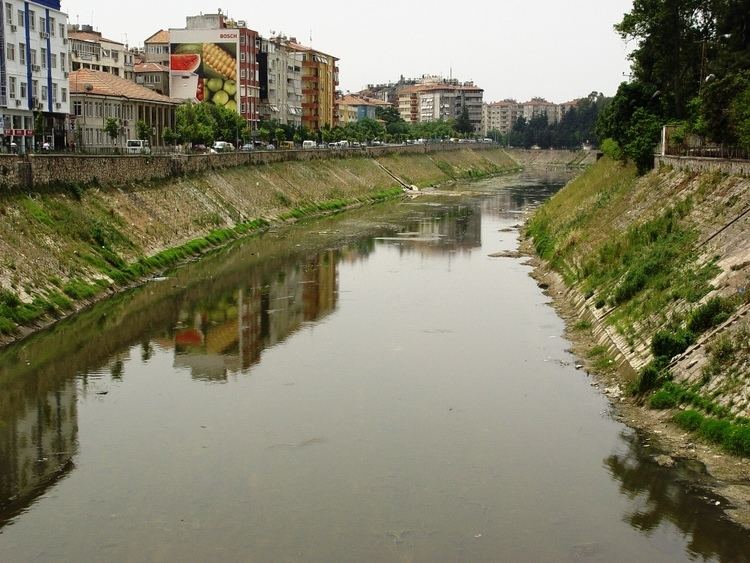- average 11 m/s (388 cu ft/s) Basin area 23,000 km² | Length 571 km Source elevation 910 m Mouth Samandağ | |
 | ||
The Orontes (/əˈrɒntiz/; Ὀρόντης) or Asi (Arabic: العاصي, ‘Āṣī; Turkish: Asi) is a northward-flowing river which begins in Lebanon and flows through Syria and Turkey before entering the Mediterranean Sea.
Contents
Map of Orontes River, Syria
In ancient times, it was the chief river of the Levant region. The modern name ‘Āṣī is derived from the ancient Axius. The word coincidentally means "rebel" in Arabic, which folk etymology ascribes to the fact that the river flows from the south to the north unlike the rest of the rivers in the region.
Name
In the 9th century BC, the ancient Assyrians referred to the river as Arantu, and the nearby Egyptians called it Araunti. The etymology of the name is unknown. Arantu gradually became "Orontes" in Greek. In contrast, Macedonian settlers in Apamea named it the Axius, after a Macedonian river god. The Arabic name "Asi" was derived from "Axius".
The Greek geographer Strabo refers to the river in the Geographica. According to Strabo, the river was originally named Typhon, because it was said that Zeus had struck the dragon Typhon down from the sky with thunder, and the river had formed where Typhon's body had fallen. He writes that the river was later renamed Orontes when a man named Orontes built a bridge on it.
Course
The Orontes rises in the springs near Labweh in Lebanon on the east side of the Beqaa Valley (in the Beqaa Governorate), very near the source of the southward-flowing Litani, and runs north, parallel with the coast, falling 600 metres (2,000 ft) through a gorge. The Ain ez Zarqa is one such major spring.
Leaving this gorge, it expands into the Lake of Homs in Syria (an artificial lake created by a Roman-era dam, also known as Qattinah lake) and through the city of Homs (or Ḥimṣ). Below is the district of Hamah (Hamaih-Epiphaneia) and the meadows of Amykes, containing the sites of ancient Apamea and Larissa. To the west is the Coastal Mountain Range. This central section ends at the rocky barrier of Jisr al-Hadid, where the river turns west into the plain of Antioch in Turkey.
Two large tributaries from the north, the southward flowing Afrin on the west and Karasu on the east join it through the former Lake of Antioch, which is now drained through an artificial channel (Nahr al-Kowsit). Passing north of the modern Antakya (ancient Antioch) the Orontes plunges southwest into a gorge (compared by the ancients to Tempe), and falls 50 metres (160 ft) in 15 kilometres (9.3 mi) to the sea just south of the little port of Samandağı (former Suedia, in antiquity Seleucia Pieria), after a total course of 450 kilometres (280 mi).
History
The Orontes is not easily navigable and the valley derives its historical importance as a road for north/south traffic; from Antioch south to Homs and thence to Damascus. On the Orontes was fought the major Battle of Kadesh (circa 1274 BCE) between the Egyptian army of Ramesses II from the south and the Hittite army of Muwatalli II from the north. The river was also the site of the Battle of Qarqar fought in 853 BCE, when the army of Assyria, led by king Shalmaneser III, encountered an allied army of 12 kings led by Hadadezer of Damascus. In 637 CE the Battle of Iron bridge was fought between the forces of the Rashidun Caliphate and the Byzantine Empire near the Iron bridge on the river made by Romans.
The Orontes has long been a boundary marker. For the Egyptians it marked the northern extremity of Amurru, east of Phoenicia. For the Crusaders in the 12th century, the Orontes River became the permanent boundary between the Principality of Antioch and that of Aleppo.
The French writer Maurice Barrès (1862–1923) wrote about the river in his Un Jardin sur l'Oronte.
